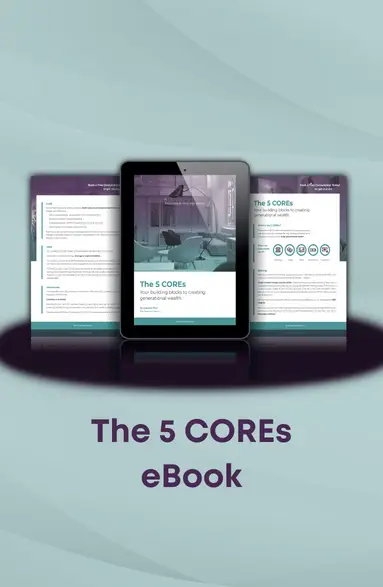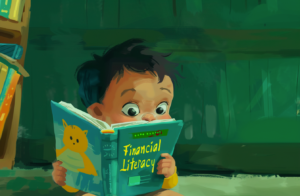Imagine a weight constantly pressing on your chest, making each breath just a little more strained. This is exactly what mounting debt feels like, a relentless burden compressing family joy and peace. For the 99% Tribe, debt isn’t just an annoying bill letter that sticks out from the stack of mail or an occasional awkward phone call from the collection agency. The beast called debt is a constant disruptor, a midnight thief stealing away the tranquillity of our hearts and homes. That’s why understanding the cycle of debt repayment becomes undoubtedly essential for every family.
We’ll be diving headfirst into this menacing whirlpool of debt that traps countless families year after year. You’ll gain a better understanding of what the cycle of debt means, how it clenches families within its cruel grip, and what happens when families unknowingly surrender to its will. This blog post is designed to be your lantern in this dark cavern of indebtedness, casting light on the unseen pitfalls and treacherous turns on this rocky debt-ridden landscape, helping you navigate towards financial freedom.
To win this battle against the gripping cycle of debt repayment, education is our greatest weapon. Armed with an understanding of the debt cycle and equipped with strategies to break the cycle, you pave the way for healthier financial practices and a debt-free future. The invaluable treasures in the form of practical tips and action steps, spread throughout this blog, will empower your family to not just combat debt but defeat it altogether. So, 99% Tribe, let’s choose knowledge over ignorance and action over resignation. It’s time to take the reins and steer our families and conquer bad debt, once and for all!
{% module_block module “widget_1690295685414” %}{% module_attribute “child_css” is_json=”true” %}{}{% end_module_attribute %}{% module_attribute “content” is_json=”true” %}”The debt cycle is a repeating pattern in the economy where people, businesses, or the government borrow money and then have to repay it later. This cycle starts when borrowing occurs to finance large purchases or investments. As borrowed money is spent, it can stimulate economic growth. However, when it’s time to repay the debt, it can create financial difficulties if you were not careful with your spending. Managing the debt cycle involves being mindful of borrowing and ensuring that debts can be repaid to maintain a stable and healthy economy. When this becomes poorly managed, you have world countries struggling to pay their debts and continuously running a deficit which can harm the overall quality of life for their people. “{% end_module_attribute %}{% module_attribute “css” is_json=”true” %}{}{% end_module_attribute %}{% module_attribute “definition_id” is_json=”true” %}null{% end_module_attribute %}{% module_attribute “field_types” is_json=”true” %}{“content”:”richtext”,”headline”:”text”}{% end_module_attribute %}{% module_attribute “headline” is_json=”true” %}”What Is The Debt Cycle?”{% end_module_attribute %}{% module_attribute “label” is_json=”true” %}null{% end_module_attribute %}{% module_attribute “module_id” is_json=”true” %}125615751593{% end_module_attribute %}{% module_attribute “path” is_json=”true” %}”/Exuberant_Growth CHILD/modules/featured-snippet”{% end_module_attribute %}{% module_attribute “schema_version” is_json=”true” %}2{% end_module_attribute %}{% module_attribute “smart_objects” is_json=”true” %}null{% end_module_attribute %}{% module_attribute “smart_type” is_json=”true” %}”NOT_SMART”{% end_module_attribute %}{% module_attribute “tag” is_json=”true” %}”module”{% end_module_attribute %}{% module_attribute “type” is_json=”true” %}”module”{% end_module_attribute %}{% module_attribute “wrap_field_tag” is_json=”true” %}”div”{% end_module_attribute %}{% end_module_block %}
Understanding the Debt Cycle: A Family Affair
Imagine a family car being firmly stuck in a mud pit. The wheels spin aimlessly, sinking deeper into the murk with every exertion. This is a striking picture of how the cycle of debt can swallow a family whole, entrapping them in a seemingly never-ending loop of repayments.
The cycle of ‘debt repayment’ is an unfortunate pattern where families borrow money to meet their immediate needs or desires without forming a solid plan to pay back the loan. It often begins innocuously, with a credit card purchase here or a personal loan there, viewed as temporary solutions to short-term problems. Over time, however, as these small debts snowball into larger ones, you run the risk of getting a second or third debt to save you from the original debt. A sense of helplessness shrouds the family, binding them within the debt cycle’s relentless grind.
One of the core reasons families find themselves in this predicament is the lack of long-term financial planning. Unforeseen emergencies, impulsive spending, limited financial literacy, and over-dependence on credit cards are all culprits that surreptitiously thrust families into the debt cycle. The consequences ensnared in this cycle can be severe. It impacts overall financial well-being, creating a chronic environment of stress and anxiety, and introducing strain in familial relationships. We all know of someone or have experienced fights about money ourselves. It’s uncomfortable and oftentimes, blame gets thrown around more than we intend. Furthermore, it creates a scary backdrop for potential bankruptcy, thus tarnishing credit scores and future borrowing prospects. After clearly understanding this dicey issue, let’s transition to the crucial aspect of fostering healthy financial habits, ensuring that families aren’t just tiptoeing around the edges of this debt pit but are walking confidently on firm and secure financial ground.
Fostering Healthy Financial Habits: The Family Fortress
There’s an old adage, “Bad habits are like a comfortable bed – Easy to get into but hard to get out of.” Financial habits are no different. But the good news is the reverse is true too. Good financial habits, while difficult to cultivate initially, yield incredible dividends over time, providing not just a secure foundation but also a safety net for the family.
The seed of good financial habits needs to be sown early. The first step in this direction is transparent communication about money matters within the family. This can clear misunderstandings, align financial goals, and encourage collective decision-making. A family setting provides a nurturing environment where each member, regardless of their age, contributes to and learns about the importance of budgeting, good spending habits, consistent saving, and future investing. Yes, I know it’s uncomfortable, it’s like spilling the tea on yourself but if you don’t come clean, it’s near impossible to build a foundation on lies and deceit. Remember, we all have a past and this includes your financial past. Leave shame, guilt, and judgment at the door and bring openness and compassion to your family meeting.
A spending plan or budget is a financial compass that helps navigate the stormy seas of debt and steer the ship toward the harbour of financial freedom. It delineates incoming and outgoing finances, aiding in identifying superfluous spending and reining it in. Combined with consistent savings and investments, these healthy habits make for a robust defence against the vicious debt cycle. Empowering each family member, especially the young ones, with these principles, and encouraging them to participate in brainstorming financial strategies, creates an aura of financial acumen in the household. YOU set the example for your children in how to manage money and whether it’s okay to talk about it openly in your family meetings or at dinner time. Practical action steps could include setting up saving goals, delaying gratification to prevent impulsive purchases, and maintaining a contingency fund for emergencies. Now, having conquered the habits, let’s move on to familiarising ourselves with the most practical strategies to tackle the monstrous mountain of debt.
Effective Strategies to Tackle Debt: The Family’s Battle Plan
Monsters under the bed are less scary when you turn on the lights and face them head-on. The same principle applies when confronting accumulated debt. The key is not to bury your head in the sand but to march forward with a sturdy battle plan, primed to combat each debt head-on.
One credible strategy to start is honesty. I can’t tell you how often this gets missed. I’ve worked with families that go “oh, I have about maybe $8,000 in debt”. Wait, maybe? As in, you are not 100% certain of the exact amount? You won’t get any judgment from me but what I won’t let slide is the fact that you NEED to know the exact amount. If you don’t, building a plan is pointless because you would not know what the final destination is when you’ve reached your goal or when.
One approach is the ‘avalanche’ method of repaying high-interest debts first. In this method, think of yourself as a mountaineer trying to scale the tallest peak, i.e., the debt with the highest interest rate. Once that’s tackled, you move to the next high-interest debt. This strategy can reduce the overall amount of interest paid over time.
For those who find motivation in small victories, the ‘snowball’ method could be the way to go. It involves clearing the smallest debt first, leading to a psychological win, and then progressing to tackle larger debts, thus maintaining momentum. Utilizing bonuses, tax returns, or any unexpected funds to make extra debt payments can expedite the escape from the debt cycle.
Adopting these strategies will empower your family to systematically and strategically confront and conquer existing debt. Do not underestimate these methods if you haven’t tried them. They sound simple, but that is the point! Once put into practice, and habits are built around these strategies, finances do get easier. But remember, the ultimate goal is not just to defeat debt but to ensure its permanent departure. To foster a lasting change, families must tune their mindset and that’s where our conversation naturally leads us next.
Cultivating a Debt-free Mindset: The Family’s Roadmap to Freedom
Just like learning a new language requires embracing a new culture, achieving financial freedom necessitates . This mindset is not inherited; it’s consciously cultivated, rooted firmly in the soil of financial discipline, and nurtured by the manure of persistent efforts.
The heart of a debt-free mindset lies in the understanding that it’s not the amount earned, but the amount saved and invested that shapes financial health. It’s about reprogramming our way of life, choosing need over want, and living within our means rather than skirting the edges of credit limits. This mindset encourages you to think twice before whipping out a credit card to finance momentary pleasures and prompts you to question each purchase’s necessity. A friendly reminder that when I mention “debt-free” I am solely referring to bad consumer debt. Once you have mastered level one, you will find more riches in leveraging debt, but that’s for different blogs. (Psst, here it is in case you’re interested and ready to level up)
A family, as a cohesive unit, can greatly contribute to the cultivation of a debt-free mindset. Parents can model sound financial practices to their children, inspiring them to embrace the advantages of a debt-free lifestyle from an early age. For instance, introducing kids to the concept of ‘earning’, ‘saving’, and ‘investing’ by allocating weekly pocket money can be a valuable learning experience. Simple practices such as eating at home more than dining out, thrifting instead of purchasing brand-new items, and planning vacations with a set budget, not only save money but demonstrates money consciousness and financial responsibility.
By maintaining a healthy dialogue around money within the family, we can pass on the baton of the debt-free mindset to the next generation. This not only liberates us from the oppressive shadows of looming debt but also lights a torch for our young ones to follow the path to financial freedom. Let’s now look at everything we have learned and gear up to dismantle the cycle of debt repayment in our quest for a debt-free existence.
Breaking the Cycle of Debt Repayment: Road to Freedom
Just as a skilled marshal devises a strategy to defeat the enemy, breaking the cycle of debt repayment requires a well-crafted, meticulous plan As we gathered our tools of knowledge in the form of understanding the debt cycle, cultivating healthy financial habits, and effective strategies to combat debt and nurtured a debt-free mindset, we are now ready to face the monster head-on.
Recall the mud pit analogy from earlier? To remove the family car from the mud, all members must work harmoniously, pushing the car, guiding the person at the wheel, and cheering on the rest. Similarly to nix the debt cycle, family involvement is critical. For starters, set a family meeting to lay out the debt situation, and create a unified front against this shared adversary. The goal is to generate a collective desire to break free from the chains of indebtedness and restore financial tranquillity as one unit. Your children may not understand the intricacies yet but they love to help and contribute to their family.
Next, arm yourself with a realistic budget that lists income, monthly expenses, debts with their interest rates, saving, and investing targets. Vigilantly sticking to this budget, and reviewing it periodically keeps the family’s finances in check. Curbs overspending ensures little to no accumulation of new debt.
Finally, with the effective strategies discussed, tackle your existing debt. This may involve initiating an avalanche or snowball method or making additional payments when possible. Over time, as debts dwindle, the light at the end of the debt tunnel shines brighter, symbolizing the family’s victory over debt.
There’s no instant magic potion to break the cycle of debt repayment; the journey toward becoming debt-free is likely to be demanding and loaded with challenges. But by staying on track with your financial goals, celebrating small victories, and fostering a strong family support network, the battle against debt can and will be won.






